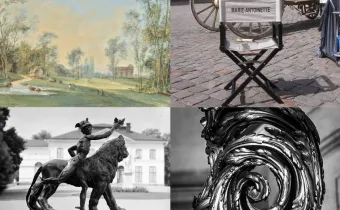A landmark event in the french revolution
Situated a few metres from the Palace of Versailles, the Royal Tennis Court was built in 1686 at the initiative of Nicolas Cretté, Louis XIV’s first master of the jeu de paume. This ancestor of modern tennis was very popular at the time. This sports hall entered history on 20 June 1789 when over 500 deputies - who were in Versailles for the meeting of the Estates-General convened by Louis XIV - gathered there and took a now-famous oath:
“ We swear never to disperse, and to meet wherever circumstances so require, until the kingdom’s Constitution is established and made firm by solid foundations. ”
This founding act of French democracy is very present in the nation’s memory, in particular because of the globally-recognised but unfinished work by the painter Jacques Louis David.
a tumultuous history
Très rapidement après le Serment, la salle du Jeu de Paume est considérée comme un lieu symbolique. Elle est acquise par la Nation et déclarée domaine national dès le 1er novembre 1793 (11 Brumaire an II). Sans usage précis, elle sert successivement d’entrepôt ou d'atelier de peintres (Antoine-Jean Gros, Horace Vernet). En 1848, le lieu est classé parmi les Monuments Historiques. Sous le Second Empire, la salle retrouve son usage d'origine de terrain de jeu de paume.
Very soon after the oath was taken, the Royal Tennis Court came to be seen as a symbolic venue. It was bought by the Nation and declared a national domain as early as 1 November 1793 (11 Brumaire an II in the Republican calendar). It did not have any designated purpose, but was used in turn as a storehouse or a painters’ studio (by Antoine-Jean Gros and Horace Vernet). In 1848, the building was listed as an Historic Monument. Under the Second Empire, the building was restored to its original purpose as an indoor court for playing the jeu de paume.
1880 marked a new phase in the venue’s destiny when the Third Republic turned it into a museum of the French Revolution. It was inaugurated on 20 June 1883 by Jules Ferry (president of the Conseil and minister of public instruction).
After another period in which it was more or less forgotten, the venue returned to the spotlight during the commemorations of the bicentenary of the French Revolution in 1989.
Since then, it has been open to the public, thanks in particular to the Palace of Versailles’ strong commitment to raising public awareness of the setting of this emblematic event in France’s history.
a necessary restoration
The building’s condition in recent times necessitated another restoration to protect and showcase the building. The operations, which were managed by Pierre Bortolussi, the Historic Monuments Head Architect, were modelled on the museum’s condition in 1883.
The roof, structure, woodwork, the painted decor in the hall and the floor were restored over a period of eight months. Work was also done on the monumental painting of the Tennis Court Oath by Luc-Olivier Merson (who completed the painting to David’s plan) and on all of the hall’s sculpted decor. This extensive project was made possible by the mobilisation of the elected members of the French National Assembly - current or former deputies - and private sponsors. It also received funding from the France Relance plan. The room will be open for guided tours and school visits from 1st April 2022.
A podcast
To coincide with the restoration, the Palace of Versailles is bringing out an original podcast to shine a spotlight on the venue’s complex history. In fictional form, it retraces the creation of the museum of the French Revolution in 1883 and the work of the painter Luc-Olivier Merson, who was tasked by the IIIrd Republic with taking over David’s plan to decorate the Royal Tennis Court.





